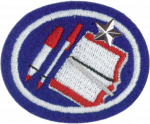Especialidades JA/Marcado de la Biblia - Avanzado/Respuestas
| Marcado de la Biblia - Avanzado | ||
|---|---|---|
| Asociación General
|
Destreza: 3 Año de introducción: Desconocido |
|
Requisitos
1
Para consejos e instrucciones, véase Marcado de la Biblia.
2
3
By its nature, selection of the texts included in a topical concordance will be more subjective than those included in an exhaustive concordance. An exhaustive concordance has the advantage of being unbiased, but the user must know all the words related to the topic under consideration. Which type of concordance you choose is a personal choice.
The first step in putting a Bible Study together is to pray and ask God to guide you. You need to put aside any preconceived notions and not be trying to "prove" something from the Bible. Once you have prepared your heart for honest Bible study, select a topic and look it up in the concordance. If the word you have looked up appears frequently in the Bible, you will need to scan the context provided to decide if the passage applies to what you are studying. Sometimes it will, and sometimes it will not. Once you find a promising text, find it in your Bible and read more of the surrounding text. If it still looks promising, write down the reference. Then return to the concordance and examine more texts.
As you read, you may become aware of more words having to do with your topic. Write these down as you go so you can look them up later. When you have a good list of texts, re-read them all and see if you can come up with a logical order for them. Once you have the texts listed and know the order you would like them to appear, it is time to mark your Bible using one of the methods outlined in the Bible Marking honor.
4
4a
Often when people begin marking their Bibles, they deviate from the "standard" way of doing it because they find a way that suits them better. There is nothing wrong with this. In fact, it makes Bible marking even more personal and meaningful to the serious Bible student. After you have marked a few studies, it is a good idea to record your procedure. Having it written down will allow you to share the method with others, or remind you of the details of your procedure sometime in the future (it's easy to forget).
4b
A key would be a summary of your shorthand notations. For instance, you might abbreviate the Second Coming as "SC", or baptism as "BZ". It may be difficult to remember what your shorthand meant later, so it's a good idea to write it down. This is true of any method you employ.
5
To younger Pathfinders this may seem a bit scary at first. They get the idea that they will have to go door-to-door offering to give strangers a Bible study. While there is much to be gained from doing that, it is not really an appropriate task for a new Bible student.
If your club has a worship period during club meetings, this is an excellent opportunity to give a Bible study. In fact, you could look at some of the AY requirements you need to meet - many of them can be met by presenting a Bible study to your club during worship time, or at a campout, during Sabbath School, or even during a family worship. The important thing is to overcome your fears and just do it.
- Categoría: Tiene imagen de insignia
- Adventist Youth Honors Answer Book/Honors/es
- Adventist Youth Honors Answer Book/es
- Adventist Youth Honors Answer Book/Skill Level 3/es
- Categoría: Libro de respuestas de especialidades JA/Especialidades introducidas en Desconocido
- Adventist Youth Honors Answer Book/General Conference/es
- Adventist Youth Honors Answer Book/Unknown/es
- Adventist Youth Honors Answer Book/Unknown/Primary/es
- Adventist Youth Honors Answer Book/Stage 0/es
- AY Honors/Prerequisite/Bible Marking/es
- AY Honors/See Also/Bible Marking/es
- Adventist Youth Honors Answer Book

